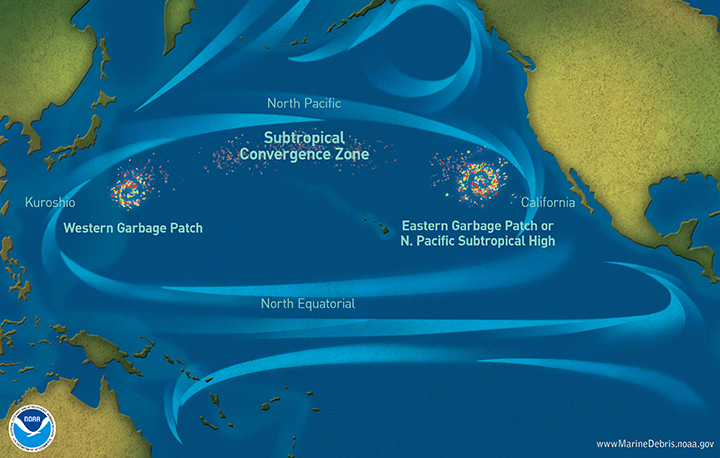There is an island in the Pacific that many people have never heard of. It’s remarkable not for its diving or its sandy, tropical beaches, but for its size and geology. The Great Pacific Garbage Patch (GPGP) sits in the North Pacific Gyre, just north of Hawaii, and though there is no scientific confirmation of its true size, some estimates range up to 15,000,000 square kilometers. Its geological foundation is a combination of plastic debris and chemical sludge.
The Great Pacific Garbage Patch

While the name may sound like something out of a Douglas Adams book, this problem is all too real. Because of the currents in the Pacific Ocean, a large proportion of the garbage and debris flushed into the Pacific all around the Pacific Rim is pushed around a vast area of the ocean before finally settling in an area north of Hawai’i. Here, it is over time compressed and slowly broken down into tiny pieces, mostly invisible to the naked eye, which make up the GPGP. The density varies greatly, making exact estimations of its size very difficult.
But how did this happen? Do ships really throw that much garbage — primarily plastic — overboard in the Pacific? The sources of the Great Pacific Garbage Patch are still being researched, but it is clear that it is not fed by any single source, such as commercial and pleasure ocean vehicles discarding garbage at sea — while this is a source of the trash, it is not the only one. Trash that has been deliberately or accidentally deposited in the ocean by humans living along Pacific Rim appears to be one of the main sources of the problem. One of the most highly populated areas of the world, the region includes the Western U.S., Latin America and the entire Pacific region of Asia. Garbage is sometimes dumped into the water on purpose, or is dumped on or near the shore, where it is then carried into the ocean by surf or wind, or both. Also, garbage that isn’t properly disposed of in inhabited areas, even relatively far from the sea, can eventually find its way there, via wind or rivers.

A number of solutions for eradicating the GPGP are being considered, but if they don’t address the underlying sources of the garbage they will make little difference in the long run. This makes national and municipal policies for garbage management all the more important. There must be stiffer fines and other penalties for garbage dumping, both on land and in the ocean, as well as stricter policies to avoid the accidental spread of garbage in urban areas, such as more and better trash cans and dumpsters. You can do your part by recycling and using less plastic — cutting consumption of pollutants leads to fewer pollutants, both in the Great Pacific Garbage Patch, and in your own backyard.

